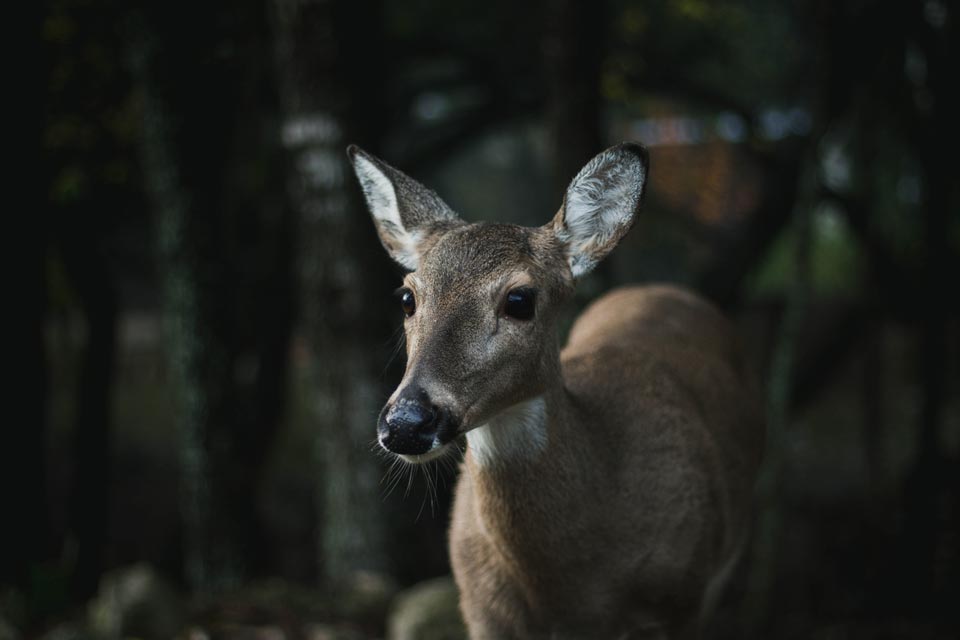Remember those weeks of marathon vegetation surveys past? Well, they are no more.
These two weeks have been all about the soils, with a few vegetation surveys thrown in.
The first week we collected vegetation data in some very dense brush. The plot was about a mile and half hike, with the last quarter mile being the toughest. We spent the last section bushwhacking through some of the densest mountain laurel I’ve ever seen.
The plot wasn’t much better, either. To illustrate this, I wanted to play a bit of a game with our readers. There’s a human-being in this photo. Can you find her? (Answer provided at end of article).

There’s a person in this picture standing about 30 yards from me. Can you find her? Hint: Lady in Red.
After a couple of really tough days doing vegetation surveys, we spent the remainder of the week (and all of this week—6 total days) collecting soil. Why all this hype about soil?
Soils are an important component of forest systems. They not only provide a medium for plant growth and water uptake, but they are also home to billions of microscopic organisms that play a crucial role in decomposition and nutrient cycling.
In this study, we are sampling the soil to better understand its chemical properties and influence on the plants growing in the forest. Under certain soil conditions—like a specific pH and set of available nutrients—do we see any plants that do exceptionally well? Are there any that are absent?
Even more importantly, though, how does soil influence plant responses after a particular management activity like logging or herbiciding? Remember: forests are complicated! The more we understand the better we can inform those managing forest lands.
So, soils are important. So important, in fact, that we spend a lot of time and energy collecting them

As a few comments on the blog have suggested, collecting soil in the Ridge and Valley Province of Pennsylvania is not easy. The sites we work in are more rock than soil, and as you might expect, it makes digging holes quite difficult. Our usual strategy involves picking a spot, removing any coarse organic material (dead leaves and such) from the surface, and prying out the rocks we find by hand as we dig to a depth of around 15 inches.
We collect each unique soil horizon (layer) encountered as we go. Sometimes this works pretty well, other times not so much. By the end of the day our hands are filthy and scratched (even with gloves!), and our fingers have been smashed at least once.
It can take us 8 hours to dig 8 holes if the soils are particularly difficult.


Just some of the many rocks we encounter on a daily basis collecting soil samples. All soil samples are bagged and dried at a later date.
I know what you’re thinking, “Why not make it easier on yourself and just mix everything together? Do you really need to collect each layer separately?” The answer is yes, we do, because the surface (organic) horizons have different chemical properties than the subsurface (mineral horizons). Basically, they are made of different stuff!
Even the mineral horizons have different properties from one another, and those properties can change depending on how water moves through the soil. In particular, soil materials (minerals and nutrients) can be deposited at deeper depths as rainwater moves through the soil via a process called illuviation.
This process physically and chemically alters both the horizon from which the deposits come from and the horizon where they are deposited.

Here you can see the difference in color between two mineral soil horizons. The darker horizon is where soil materials have been deposited with movement of rainwater over time.
Did you ever think you’d know so much about soils?
Lucky for us, we only spend 50% of our time digging rocks out of the ground. The rest of the time we get the opportunity to do vegetation surveys and see some pretty awesome wildlife. Our extra stuff for the week? Our first timber rattlesnake of the year, a slimy salamander, wood turtle, a sphinx moth, and barred owl—all on the SAME day!

Northern slimy salamander (Plethodon glutinosis)

Wood turtle

Sphinx moth

Timber rattlesnake
We had a day full of all the extra stuff this week.
It really does make some of these long trips to the remote parts of the state forest worth every moment!
Oh, and in case you were wondering:
Ph.D graduate student
This week’s Deer Plate Special!
Common Name: Round Leaf Greenbrier or Catbrier
Scientific name: Smilax rotundifolia
Description: A perennial understory vine with green stems and round, leathery leaves. Climbing with tendrils, greenbrier can easily reach heights greater than 30 feet with the appropriate medium to climb on. Leaves are alternately arranged and have long, obvious parallel veins. Sharp thorns protect the stems. Deer prefer to eat stems and leaves, particularly the new growth. Tendrils are said to be edible by humans (or tender spring growth can be steamed like asparagus).
Size: Highly variable from 2’’ for newly germinated plants to heights greater than 30 feet for well-established vines in the forest midstory.
Wildlife Value: Numerous birds and mammals eat greenbrier fruits. The persistent fruits are an important late winter and early spring food for wintering birds. Deer and rabbits browse the foliage. It is considered an important winter browse for deer. The impenetrable ticket that greenbrier creates is good cover for small mammals and birds. 

